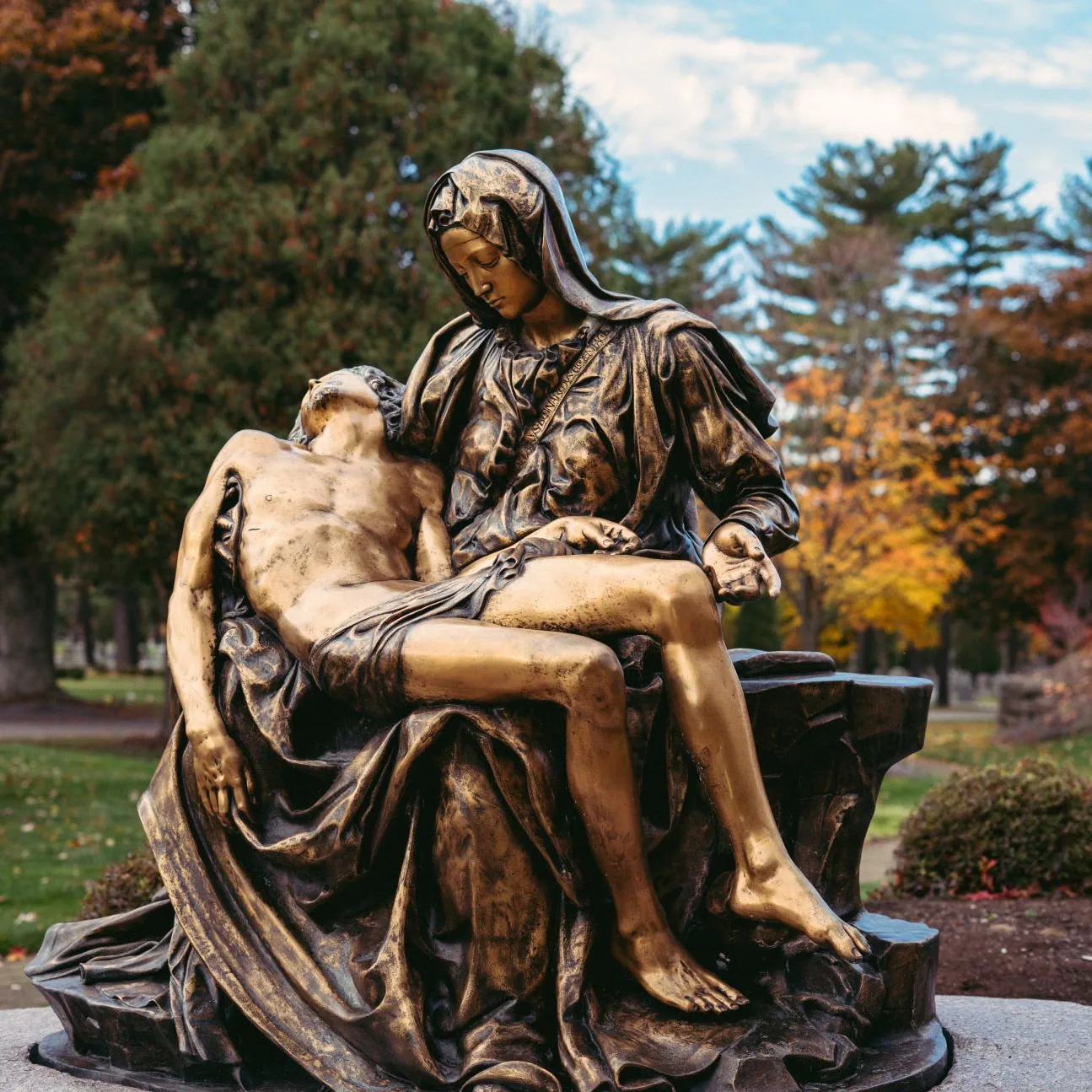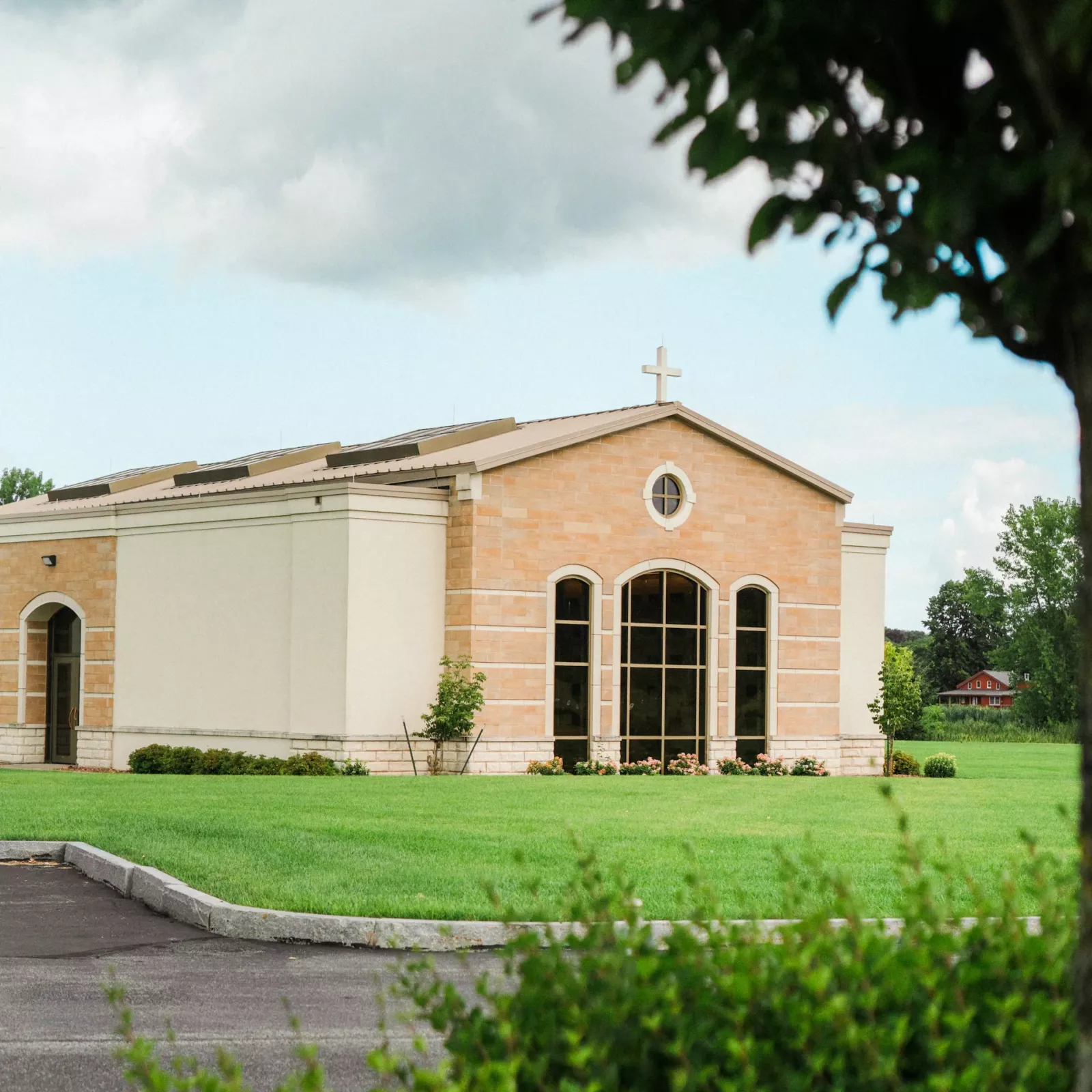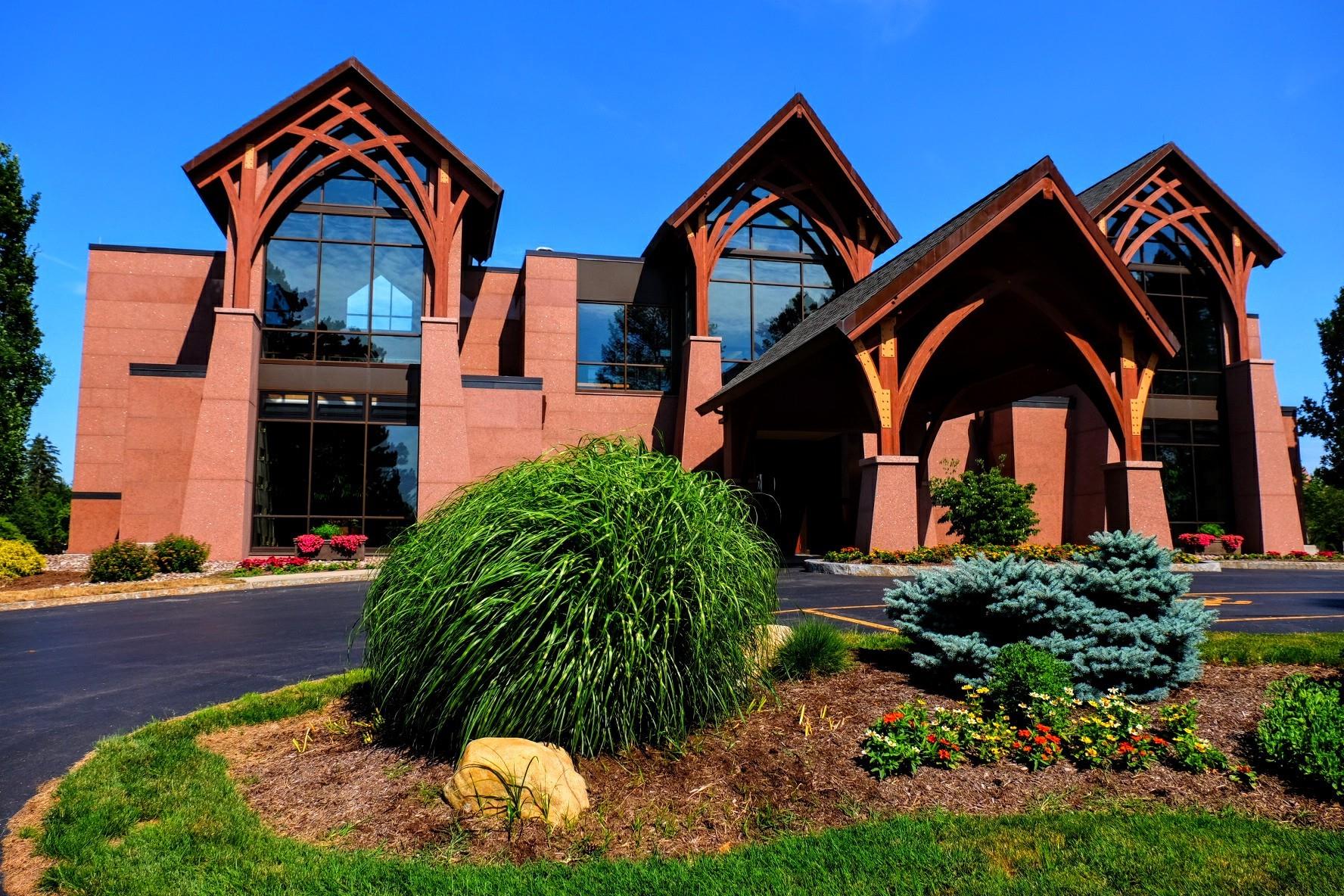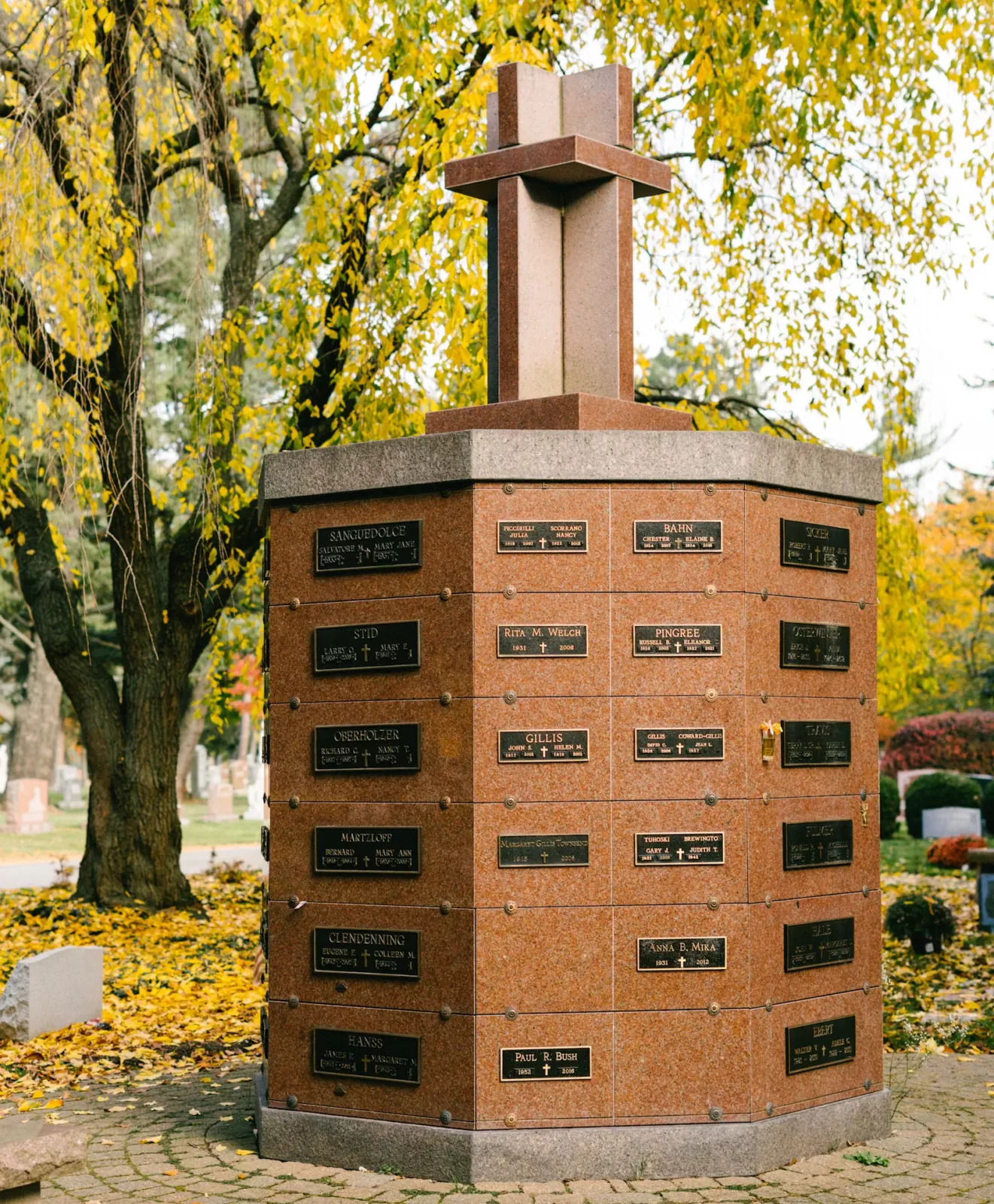Catholic Church on Cremation Statement
The Catechism of the Catholic Church devotes a single sentence to cremation: “The Church permits cremation, provided that it does not demonstrate a denial of faith in the resurrection of the body” (no. 2301).
The United States Conference of Catholic Bishops, while noting that cremation is permitted, stresses that the Church holds a preference for full-body burial. The USCCB explained, “The Church’s reverence and care for the body grows out of a reverence and concern for the person whom the Church now commends to the care of God. The human body is so inextricably associated with the human person that it is hard to think of a human person apart from his or her body.”
Any baptized Catholic can purchase burial space in a Catholic cemetery. Rights to burial space purchased by a baptized Catholic may be passed on to others, according to New York State law, regardless of their beliefs or religious affiliations.
As Catholic cemeteries, Holy Sepulchre and Ascension Garden carry out the sacred religious function of burial and care of the resting places of the deceased members of our faith community. Those who choose burial in a Catholic cemetery are re-confirming their belief in the resurrection of the body and of eternal life with Christ. We ask all visitors to respect these Catholic principles and governing rules.
Yes. In May 1963, the Vatican’s Holy Office (now the Congregation for the Doctrine of Faith) lifted the prohibition forbidding Catholics to choose cremation. This permission was incorporated in the revised Code of Canon Law of 1983 (Canon #1176), as well as the Order of Christian Funerals.
The Church emphasizes that cremated remains must be given the same respect as the body. This includes a worthy container to hold the remains, and a proper Catholic burial—either above-ground (in a mausoleum or columbarium), or in-ground. The scattering of remains or keeping them in an urn for decorative purposes is not permitted by the Church.
Cremation is Catholic when it is “of the Church” — that is, everything surrounding cremation, in all aspects, embodies the faith and practice of the Church. Cremation for Catholics flows from the mission of the Church—to teach, to come together in community, and to serve. Cremation is Catholic when the Order of Christian Funerals is celebrated in its liturgical fullness. This includes prayers at the time of death in the presence of the body, a vigil prayer during the time of the wake, a Funeral Liturgy, and the rite of committal. Cremation is Catholic when the cremated remains of the body are committed to the ground or a niche in a Catholic cemetery. As part of a continuum of faith with the parish community, Catholic cemeteries call to mind the resurrection of the dead and the communion of saints.
First, discuss your questions with a knowledgeable pastor or parish staff person, or contact The Catholic Cemeteries for more information. Second, if your decision is to be cremated, make your wishes known in your will or in documents designed to help plan your funeral and burial. Provide copies of these documents to family members, your pastor, funeral home, or Catholic cemetery. Lastly, as you plan, keep in mind the therapeutic value to your family of celebrating the full funeral liturgy with the body present. Think of cremation of the body and committal of the remains as the conclusion of a funeral with the body.
The Church prefers that cremation take place after the full funeral liturgy with the body. Sometimes, however, it is not possible for the body to be present for the funeral liturgy. When extraordinary circumstances make the cremation of the body the only feasible choice, pastoral sensitivity must be exercised by all who minister to the family of the deceased.
If the body is present for the funeral liturgy, with cremation to follow, you may rent a casket or purchase a special cremation casket that will later be consumed in the cremation process. In situations where the body cannot be present for the funeral liturgy, a casket would not be necessary nor would the body need to be embalmed. However, the crematorium requires that the body be placed in a combustible, outer container prior to entry into the cremation chamber.
After cremation of the body occurs, the cremated remains must be placed in an appropriate container. An appropriate container need not be expensive. The crematorium usually returns the cremated remains in a cardboard or plastic container; this meets minimum requirements for inurnment in the cemetery. Classic urns, made of metal, bronze, or wood, can also be purchased from the cemetery or the funeral home. Other worthy vessels, made of suitable and respectful material, already in a family’s possession may also be used.
Although jewelry, dishes, statuary, and space capsules are offered commercially, they are unacceptable receptacles for cremated remains in Catholic funeral practices. It is also unacceptable for Catholics to have cremated remains made into jewelry, artwork, or other objects of display or consumption.
Presence of the body at the funeral liturgy:
The Church prefers and urges that the body of the deceased be present for the vigil and the funeral mass, since the presence of the body better expresses the values which the Church affirms in these rites. In this scenario, following the funeral liturgy at the parish church, the family may find it consoling and meaningful to go in procession to the crematorium and be present for the placement of the body into the cremation chamber. In any case, after the cremation is completed, the family should gather later for the Rite of Committal at the cemetery.
Presence of the cremated remains of the body at the funeral liturgy:
In accord with the indult granted by Rome to the bishops of the United States, all the rites of the Order of Christian Funerals can be celebrated in the presence of the cremated remains. The cremated remains should be contained in an appropriate vessel and treated with the respect and dignity accorded to the body, including the respectful transportation and handling of the cremated remains to and from the church. A small table or stand is to be prepared for the container at the place normally occupied by a casket. The container may be carried in during the entrance procession or it may be placed on a table or stand before the liturgy begins. Holy water and incense may be used to reverence the cremated remains and the Easter candle will be burning nearby; however, the pall is not used. Photos and other mementos may be used at the vigil but are not appropriate for the mass. The rite of committal is celebrated at the cemetery as soon as possible following the funeral liturgy. The cremated remains, like the body, are always laid to rest with solemnity and dignity.
No body or cremated remains of the body present at the funeral liturgy:
In those pastoral situations when cremation and committal take place before the funeral liturgy, a vigil prayer, visitation, and rite of committal may occur before the funeral liturgy. The funeral mass is celebrated as indicated in the Order of Christian Funerals. Prayers which do not make reference to the honoring or burying of the body of the deceased are chosen instead of those having those themes. Families are encouraged to gather together for a meal after mass has concluded.
The Church requires that the cremated remains be either buried in the ground in a cemetery or placed in a mausoleum or columbarium, preferably in a Catholic cemetery. The Church recommends that the place of burial or entombment be permanently memorialized with a traditional memorial stone, crypt/niche front, or bronze plaque, minimally marking the name and dates of birth and death of the deceased person. Since the human body was the temple of the Holy Spirit during life, was fed at the Eucharistic table, and will share in the bodily resurrection, contemporary cultural practices like scattering the cremated remains over water or from the air or keeping the cremated remains at home are not considered reverent forms of disposition that the Church requires. Other practices such as commingling cremated remains or dividing up cremated remains among family members or friends are not acceptable for Catholics.
There are two primary options for the final disposition of cremated remains in a cemetery: in-ground burial or above-ground inurnment.
Ground burial of cremated remains
- Cremated remains can be buried in a full size grave.
- Cremated remains can be buried in a smaller size cremation grave located in areas designated only for cremation burial.
- Cremated remains can be buried on top of an existing grave occupied by another person, provided permission is given by the lot owner and observance of the cemetery’s rules for memorialization are followed.
Above-ground inurnment of cremated remains
- Cremated remains may be inurned in a crypt or niche located in a mausoleum building.
- Cremated remains may be interred in a columbarium facility which may be a free-standing bank of niches located in the cemetery or attached to a building in the cemetery.
Rules & Regulations
At Holy Sepulchre Cemetery & Ascension Garden combined, there are more than 250,000 burials with more each day. Maintaining the beautiful grounds is a top priority to insure that the cemeteries are always places of prayerful reflection. Policies have been created to ensure that the beauty of the cemeteries remain intact for many years to come, and that personal decorations do not infringe upon the space of neighboring plots, crypts and niches.
Please be aware that lot holders own the right of burial space in a cemetery while the ownership and responsibility for the general upkeep of the property remains with the cemetery. Holy Sepulchre and Ascension Garden take pride in the appearance and beauty of the grounds and therefore respectfully ask the cooperation of lot holders in abiding with a few simple rules to enhance a sense of order for the mutual benefit of all.
Helpful Links
There are many resources in the Diocese of Rochester that can assist people during various times in their lives. The following is a list of important links that you can link to and find the numerous resources that our Diocese provides.
Diocese of Rochester
www.dor.org
Parishes within the Diocese of Rochester
www.dor.org/DORhomepage/parishlinks.htm
Catholic Courier
www.catholiccourier.com
New York State Association of Cemeteries
www.nysac.com
Rochester Genesee Valley Funeral Directors Association
www.rgvfd
United States Conference of Catholic Bishops (USCCB)
www.usccb.org
Other Catholic Dioceses in New York
Archdiocese of New York www.ny-archdiocese.org
Albany www.rcda.org
Brooklyn www.dioceseofbrooklyn.org
Buffalo www.buffalodiocese.org
Ogdensburg www.dioogdensburg.org
Rockville Centre www.drvc.org
Syracuse www.syracusediocese.org
New York State Catholic Conference (NYSCC) www.nyscatholicconference.org
Ministry
Vatican Statement on Christian Burial
Since Vatican II the church does allow the cremation option under certain circumstances and understandings. In Cannon 1176 paragraph 3 it is written; “The church earnestly recommends that the pious custom of burying the bodies of the dead be observed; it does not, however, forbid certain cremation unless it has been chosen for reasons which are contrary to Christian teaching.”
Ministry of Consolation
According to the Order of Christian Funeral, it is the obligation of all to minister to those who are in grief due to the loss of a loved one. The Church calls each member of Christ’s Body- priest, deacon, layperson to participate in the ministry of consolation: to care for the dying, to pray for the dead, to comfort those who mourn. The responsibility for the ministry of consolation rests with the believing community.
The Order of Christian Funeral
“At the death of a Christian, whose life of faith was begun in the waters of baptism and strengthened at the Eucharistic table, the Church intercedes on behalf of the deceased because of its confident belief that death is not the end . . Christians celebrate the funeral rites to offer worship, praise, and thanksgiving to God for the gift of a life which has now been returned to God.” (Order of Christian Funerals, 4-5)
Funeral Rite
The Catholic Church has a beautiful three-part plan for funerals. If our schedules permitted, members of the community would walk with the bereaved family through all three parts of the funeral rites (from vigil through burial). Each of these rites has a distinctive purpose and is described below.

Vigil for the Deceased (Wake)
The Vigil is the official prayer of the church for the deceased in the time following death and before the funeral liturgy; or if there is no funeral liturgy, before the rite of committal. It should not be omitted or replaced by devotional prayers (such as the rosary). Devotional prayers may be offered in addition to the celebration of the Vigil for the Deceased either at the time of the Vigil itself, or at another time. The vigil may take place in the home of the deceased, at a funeral home, or in church. A priest, deacon or layperson may preside at this liturgy. The vigil consists of readings from sacred Scripture, songs, psalms and intercessions. A brief homily or reflection is included. The vigil is the preferred time for family and friends to tell stories, and to offer reflections and eulogies. In today’s society, the vigil has often been minimized by a lack of participation by friends and family, who sometimes spend only a few moments at the funeral home viewing the body and offering condolences to the family; but a full celebration of the vigil is the appropriate beginning of the funeral rites.
Funeral Liturgy
The Funeral Mass is the primary liturgical celebration of the Christian community for the deceased. The Funeral Liturgy (Mass) celebrates the life of the deceased Christian by reaffirming the baptismal share in Christ’s death and resurrection and looking forward to a continued share in that life in the kingdom of heaven. At the Funeral Liturgy the assembly receives the body of the deceased in a casket, which is sprinkled with holy water and has a pall placed upon it to recall the deceased’s baptism. Then the body is carried toward the altar and placed near the Easter candle. The Mass continues as usual. The homily is based on the readings and focuses on the paschal mystery (death/resurrection). A final commendation follows the prayer after Communion. Then the body is incensed (offered to God) and a song of farewell is sung to affirm our hope in life everlasting. The body is then carried to the place of burial (committal).
Rite of Committal
The Rite of Committal concludes the funeral rites. This brief rite helps the bereaved at this difficult time of parting. It includes a short Scriptural verse, the prayer of committal, intercessions, the Lord’s Prayer and a blessing. The body is then lowered into the grave or placed in a tomb or crematorium. A song may conclude this rite.







